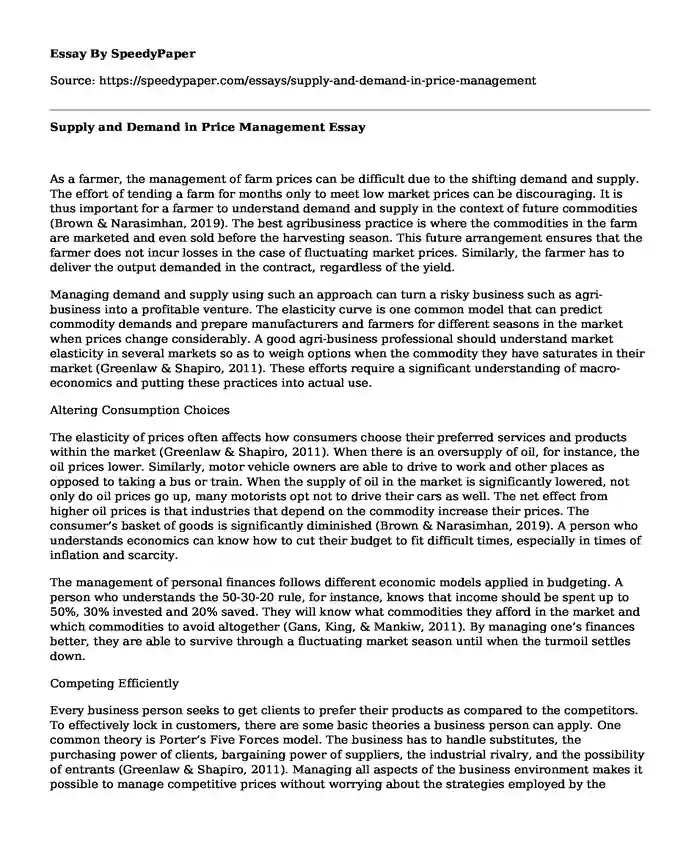
| Type of paper: | Essay |
| Categories: | Finance Analysis Technology |
| Pages: | 3 |
| Wordcount: | 622 words |
As a farmer, the management of farm prices can be difficult due to the shifting demand and supply. The effort of tending a farm for months only to meet low market prices can be discouraging. It is thus important for a farmer to understand demand and supply in the context of future commodities (Brown & Narasimhan, 2019). The best agribusiness practice is where the commodities in the farm are marketed and even sold before the harvesting season. This future arrangement ensures that the farmer does not incur losses in the case of fluctuating market prices. Similarly, the farmer has to deliver the output demanded in the contract, regardless of the yield.
Managing demand and supply using such an approach can turn a risky business such as agri-business into a profitable venture. The elasticity curve is one common model that can predict commodity demands and prepare manufacturers and farmers for different seasons in the market when prices change considerably. A good agri-business professional should understand market elasticity in several markets so as to weigh options when the commodity they have saturates in their market (Greenlaw & Shapiro, 2011). These efforts require a significant understanding of macro-economics and putting these practices into actual use.
Altering Consumption Choices
The elasticity of prices often affects how consumers choose their preferred services and products within the market (Greenlaw & Shapiro, 2011). When there is an oversupply of oil, for instance, the oil prices lower. Similarly, motor vehicle owners are able to drive to work and other places as opposed to taking a bus or train. When the supply of oil in the market is significantly lowered, not only do oil prices go up, many motorists opt not to drive their cars as well. The net effect from higher oil prices is that industries that depend on the commodity increase their prices. The consumer's basket of goods is significantly diminished (Brown & Narasimhan, 2019). A person who understands economics can know how to cut their budget to fit difficult times, especially in times of inflation and scarcity.
The management of personal finances follows different economic models applied in budgeting. A person who understands the 50-30-20 rule, for instance, knows that income should be spent up to 50%, 30% invested and 20% saved. They will know what commodities they afford in the market and which commodities to avoid altogether (Gans, King, & Mankiw, 2011). By managing one's finances better, they are able to survive through a fluctuating market season until when the turmoil settles down.
Competing Efficiently
Every business person seeks to get clients to prefer their products as compared to the competitors. To effectively lock in customers, there are some basic theories a business person can apply. One common theory is Porter's Five Forces model. The business has to handle substitutes, the purchasing power of clients, bargaining power of suppliers, the industrial rivalry, and the possibility of entrants (Greenlaw & Shapiro, 2011). Managing all aspects of the business environment makes it possible to manage competitive prices without worrying about the strategies employed by the competition. Similarly, the business is able to sustain quality standards and meet consumer demands even when there is an inherent urge to use unfair business tactics. A business person who understands economics also knows when to offer incentives to consumers, based on the market forces affecting the business, such as; inflation, oversupply and general economic depression (Gans, King, & Mankiw, 2011).
References
Brown, C., & Narasimhan, S. (2019). Principles of Macroeconomics. Economics, 2020, 300. Retrieved from https://www.colorado.edu/economics/sites/default/files/attached-files/2020-300_0.pdf
Gans, J., King, S., & Mankiw, N. G. (2011). Principles of microeconomics. Cengage Learning. Retrieved from https://static.scs.georgetown.edu/upload/files/syllabi/term_201820/course_ECON-001/section_20/ECON-001-20.pdf
Greenlaw, S. A., & Shapiro, D. (2011). Principles of Macroeconomics 2e. Rice University, Houston, TX.
Cite this page
Supply and Demand in Price Management. (2022, Dec 06). Retrieved from https://speedypaper.net/essays/supply-and-demand-in-price-management
Request Removal
If you are the original author of this essay and no longer wish to have it published on the SpeedyPaper website, please click below to request its removal:
- Police Brutality Essay Sample
- Nursing Reflection Paper Example for Your Free Use
- Maintaining your relationship
- Free Essay on Chinese Economics - China's Trade Liberalization
- Fear and Human Behavior - The Modern Day Witch Hunt
- Essay Example on Amnesia Disorder to Healthy Memory
- Essay Sample on Human Trafficking and Child Labour in Indonesia
Popular categories




